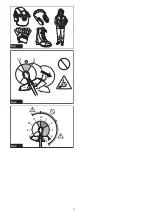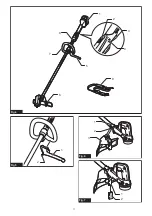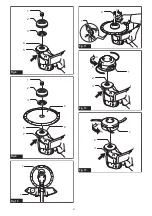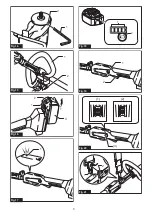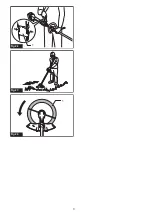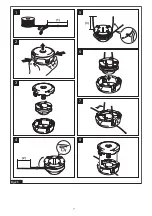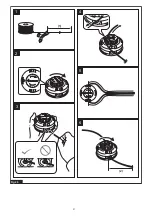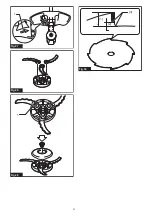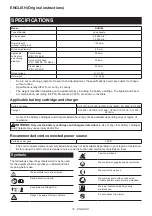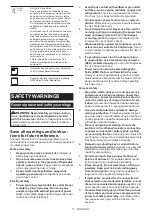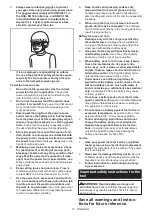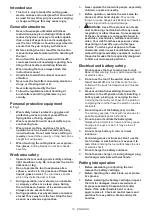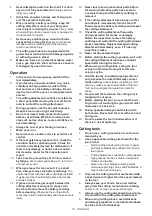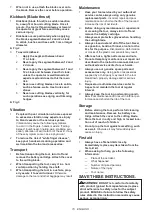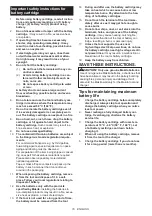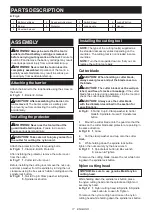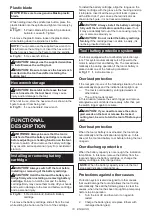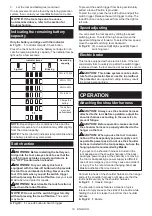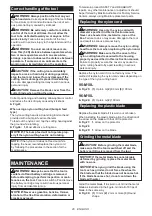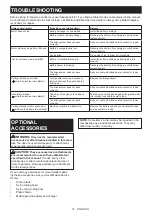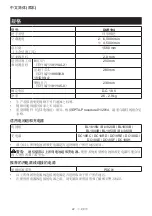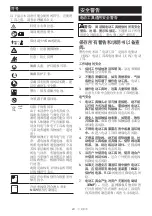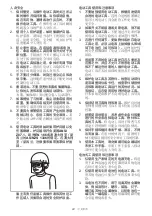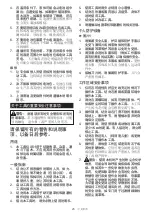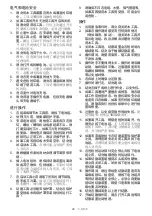
11 ENGLISH
Ni-MH
Li-ion
Only for EU countries
Due to the presence of hazardous com-
ponents in the equipment, waste electrical
and electronic equipment, accumulators
and batteries may have a negative impact
on the environment and human health.
Do not dispose of electrical and electronic
appliances or batteries with household
waste!
In accordance with the European Directive
on waste electrical and electronic equip-
ment and on accumulators and batteries
and waste accumulators and batteries,
as well as their adaptation to national law,
waste electrical equipment, batteries and
accumulators should be stored separately
and delivered to a separate collection point
for municipal waste, operating in accor-
dance with the regulations on environmen-
tal protection.
This is indicated by the symbol of the
crossed-out wheeled bin placed on the
equipment.
Guaranteed sound power level according
to EU Outdoor Noise Directive.
Sound power level according to Australia
NSW Noise Control Regulation.
SAFETY WARNINGS
General power tool safety warnings
WARNING:
Read all safety warnings, instruc-
tions, illustrations and specifications provided
with this power tool.
Failure to follow all instructions
listed below may result in electric shock, fire and/or
serious injury.
Save all warnings and instruc-
tions for future reference.
The term “power tool” in the warnings refers to your
mains-operated (corded) power tool or battery-operated
(cordless) power tool.
Work area safety
1.
Keep work area clean and well lit.
Cluttered or
dark areas invite accidents.
2.
Do not operate power tools in explosive atmo-
spheres, such as in the presence of flammable
liquids, gases or dust.
Power tools create sparks
which may ignite the dust or fumes.
3.
Keep children and bystanders away while
operating a power tool.
Distractions can cause
you to lose control.
Electrical safety
1.
Power tool plugs must match the outlet. Never
modify the plug in any way. Do not use any
adapter plugs with earthed (grounded) power
tools.
Unmodified plugs and matching outlets will
reduce risk of electric shock.
2.
Avoid body contact with earthed or grounded
surfaces, such as pipes, radiators, ranges and
refrigerators.
There is an increased risk of elec-
tric shock if your body is earthed or grounded.
3.
Do not expose power tools to rain or wet con-
ditions.
Water entering a power tool will increase
the risk of electric shock.
4.
Do not abuse the cord. Never use the cord for
carrying, pulling or unplugging the power tool.
Keep cord away from heat, oil, sharp edges
or moving parts.
Damaged or entangled cords
increase the risk of electric shock.
5.
When operating a power tool outdoors, use an
extension cord suitable for outdoor use.
Use of
a cord suitable for outdoor use reduces the risk of
electric shock.
6.
If operating a power tool in a damp location
is unavoidable, use a residual current device
(RCD) protected supply.
Use of an RCD reduces
the risk of electric shock.
7.
Power tools can produce electromagnetic
fields (EMF) that are not harmful to the user.
However, users of pacemakers and other similar
medical devices should contact the maker of their
device and/or doctor for advice before operating
this power tool.
Personal safety
1.
Stay alert, watch what you are doing and use
common sense when operating a power tool.
Do not use a power tool while you are tired or
under the influence of drugs, alcohol or med
-
ication.
A moment of inattention while operating
power tools may result in serious personal injury.
2.
Use personal protective equipment. Always
wear eye protection.
Protective equipment such
as a dust mask, non-skid safety shoes, hard hat or
hearing protection used for appropriate conditions
will reduce personal injuries.
3.
Prevent unintentional starting. Ensure the
switch is in the off-position before connecting
to power source and/or battery pack, picking
up or carrying the tool.
Carrying power tools with
your finger on the switch or energising power tools
that have the switch on invites accidents.
4.
Remove any adjusting key or wrench before
turning the power tool on.
A wrench or a key left
attached to a rotating part of the power tool may
result in personal injury.
5.
Do not overreach. Keep proper footing and
balance at all times.
This enables better control
of the power tool in unexpected situations.
6.
Dress properly. Do not wear loose clothing or
jewellery. Keep your hair and clothing away
from moving parts.
Loose clothes, jewellery or
long hair can be caught in moving parts.
7.
If devices are provided for the connection of
dust extraction and collection facilities, ensure
these are connected and properly used.
Use of
dust collection can reduce dust-related hazards.
8.
Do not let familiarity gained from frequent use
of tools allow you to become complacent and
ignore tool safety principles.
A careless action
can cause severe injury within a fraction of a
second.
Summary of Contents for DUR194SFX2
Page 2: ...2 Fig 1 Fig 2 12 1 2 3 4 5 11 10 9 8 Fig 3 ...
Page 3: ...3 1 8 2 3 4 5 6 9 7 Fig 4 1 2 Fig 5 1 3 2 Fig 6 2 1 Fig 7 ...
Page 5: ...5 1 2 Fig 14 1 2 Fig 15 3 1 2 Fig 16 1 Fig 17 1 2 Fig 18 2 1 Fig 19 1 2 3 Fig 20 1 2 Fig 21 ...
Page 6: ...6 1 Fig 22 Fig 23 1 Fig 24 ...
Page 7: ...7 1 2 3 5 4 6 7 8 1 2 3 Fig 25 ...
Page 8: ...8 1 2 4 3 5 6 1 2 Fig 26 ...


